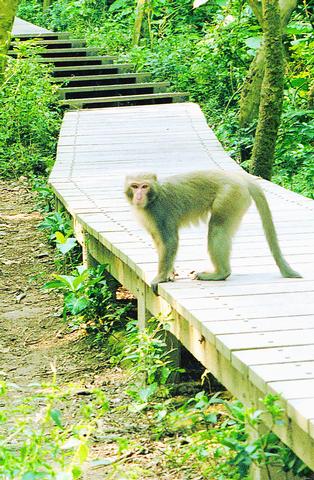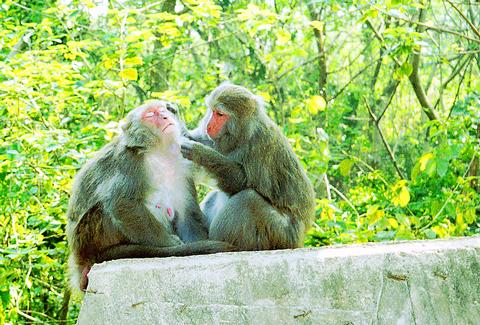|
Monkey
business at Takao Hill
Formosan
rock macaque monkeys have lived at Kaohsiung's Takao
Hill for longer than anyone has lived in Kaohsiung. Now
their habitat, and the monkeys themselves, are under
threat from a flood of visitors and a government bent on
building an animal-unfriendly nature park
By Chiu Yu-tzu - STAFF REPORTER
 |
|
Conservationists
have found that the monkeys inhabiting Takao
Hill nature park near Kaohsiung seem to prefer
getting around on the same footpaths used by
visitors to the park.
PHOTO: CHIU YU-TZU,
TAIPEI TIMES
|
The
Kaohsiung City Council passed regulations prohibiting
the feeding of monkeys at the city's Takao Hill (打狗山)
on Jan. 17. Any act of charity towards the monkeys is
now punishable by an NT$6,000 fine. It has done little,
though, to stop all the monkey business at Takao Hill,
activists and animal conservationists say.
The
Formosan rock macaque monkeys (
台灣彌猴
, Macaca
cyclopis) that live on the hill have become
overweight and even diagnosed with hypertension due to
the many visitors to the area that have indulged them
with all kinds of snacks.
"Because
the monkeys can get food so easily, they have become
spoiled and have learned how to beg for food from
mountain climbers ... they even aggressively snatch food
away. It's unnatural," said Yang Ping-yu (楊娉育),
the executive general of the Takao Hill Park Association
(柴山自然公園促進會).
The
330m-high hill has long been home to the species. Their
activities were first recorded in 1862 by English
zoologist Robert Swinhoe, who named the endemic
round-faced monkey Macaca cyclopis in his book Formosan
Mammalians.
The
species is known for its dark gray skin and cheek
pouches, which it uses to carry food in while foraging.
The
macaque consumes fruits, leaves, berries, seeds, insects
and small vertebrate animals. It's tail, however, is
medium length and not prehensile, making it impossible
for it to assist the monkey when it climbs trees.
Swinhoe
sent a pair of the Formosan rock macaques to a zoo in
London and the exhibition reportedly drew a lot of
attention from Western biologists.
Today,
some 700 to 1,000 of the monkeys live on what foreigners
once called Ape Hill.
However,
Swinhoe probably never expected that over 130 years of
attention from humans would threaten the species.
 |
|
Many
people come to Takao Hill to observe monkeys'
behavior, such as their grooming, which is meant
to remove debris and parasites from their hair
and is most often done by their mate.
PHOTO: CHIU YU-TZU,
TAIPEI TIMES
|
Mismanaged
Park
While
the Kaohsiung City government has mapped out 500
hectares of the hill as a protected area, the park has
no designated entrance.
Traveling
along an almost hidden cement path beside Lungchuan
Temple (龍泉寺),
in the Gushan district (鼓山區)
of Kaohsiung city, mountain climbers who visit for the
first time might have difficulty imagining the majestic
scenery that's hidden behind the temple.
Dozens
of families who live near the temple have complained
that their quality of life has been ruined by thousands
of day hikers forced to share limited parking space, as
well as by hawkers who sell their wares at the base of
the hill.
But
even before the mountain opened to the public, residents
complained about the monkeys, which invaded their
backyards, scavenging for any available food.
"People
have come now and the monkeys have retreated. A new
battle is taking place on the mountain," one
resident said.
Conservationists
say the conflict could be attributed to the government's
over-development of the area, which has added numerous
pavilions, park benches and pathways to the mountain.
Walking
on a wooden-plank footpath, visitors can tour the hill
within the span of an hour -- provided they aren't
distracted by monkeys along the way.
"We've
found that monkeys seem to prefer walking on pathways to
swinging in the woods," said Huang Li-ting (
黃莉婷
), an
activist with the Takao Hill Park Association.
In
the mountain, it is common for visitors to have to make
way for a group of monkeys running along the footpath.
While
resting at one of the pavilions, visitors are often
approached by monkeys begging and screaming for food.
Many say they find the urge to feed the monkeys
irresistible despite the law.
Based
on their experience, monkeys have figured out that food
is usually kept inside plastic bags. As a result, many
of those who carry plastic bags are often attacked by
aggressive monkeys, conservationists say.
"Some
clever monkeys even know how to suck juice from
cartons," said Huang, who has been observing the
park's ecology for years.
But
Huang is not totally against individuals coming to visit
the mountain.
Some
people come the hill to observe the monkeys' behavior,
such as their grooming, she says. Monkeys groom to
remove chips, salt particles and parasites from their
hair.
"Observing
is a good thing. But people get deeply involved in the
monkeys' life by feeding them," Huang said.
`Never
feed monkeys'
Feeding
continues, regardless of the signs posted around the
park.
"Never
Feed Monkeys," is one of several "Nevers"
ardently urged by the city government to remind visitors
of the potential dangers of mischievous monkeys.
However, notices advising to "Never bring
pets" and "Never bring food" often go
totally unheeded.
Pet
owners holding their dogs and cats, which are scared by
monkeys, are a common sight along the park's footpaths.
Other
notices urge visitors to avoid feeding, attacking and
staring at the monkeys. But few heed this advice as
well. While visiting the mountain recently, a small
group of teenagers in school uniforms walked by with
popguns in hand ready to scare monkeys and take what
they called "revenge" without adults' company.
"Some
detestable monkey stole fruit and broke the antennae on
my TV," said one teenager. Amazingly, not only
teenagers but also adults use popguns to scare monkeys
"just for fun."
Activists
say that what the park needs most is comprehensive
management, not more pavilions and park benches.
In
addition to the famous native monkeys, there are other
treasures within the park that equally deserve
protection.
Visitors
can easily find the fossils of sea urchins on the ground
because the hill, formed between 80,000 and 120,000
years ago, was once coral reefs under the sea.
Additionally,
several shell mounds (
貝塚
)
discovered at prehistoric sites have helped
archeologists picture the life of aboriginal people
hundreds, even thousands of years ago.
City
government no help
Environmentalists
say that thoughtless management practices carried out by
the government have accelerated the environmental
deterioration within the park.
Last
December, the city government, which has asked visitors
not to bring food to the mountain, provided 55 sets of
wooden tables and benches for picnickers that the
monkeys now frequent themselves.
The
benches and tables were provided following an overall
cleanup of hundreds of tables and couches placed without
permission by individuals last September.
Some
1,300 volunteer workers have also dismantled 19
buildings which were built without first obtaining a
proper license. Some of the illegal villas were even
owned by legislators.
The
official cleanup was carried out following pressure from
various environmental groups.
Last
May, the "Rescuing Takao Hill" action was
initiated by several local groups, including the Takao
Hill Park Association, the Kaohsiung City Green
Association (高雄市綠色協會),
Kaohsiung City Teachers' Association (高雄市教師會)
and the Chunghwa Telecom Workers' Union (中華電信工會).
Activists
collected more than 10,000 signatures on a petition
urging Kaohsiung City Mayor Frank Hsieh (謝長廷)
to protect the area.
Environmentalists'
aggressive action has caused a violent reaction among
residents living in the area. When the government began
razing illegal buildings last June, angry residents
allegedly assaulted conservationists standing to the
side, including Li Ken-cheng (
李根正
), an
elementary school teacher, and Yang Ping-yu, an activist
with the Takao Hill Park Association.
Officials
with the Kaohsiung City government said that they have
encountered difficulties for years in managing the park.
"We
wanted to get land from Taiwan Cement Corporation (台灣水泥公司)
to build an official gate in order to limit the amount
of visitors, but failed," said an official of the
city's Bureau of Reconstruction, who wished to remain
anonymous.
One
of Taiwan Cement's sites located by the mountain has
mined limestone from the area for decades and more
recently served as a blockade to visitors.
Officials
with the Bureau of Reconstruction told the Taipei Times
that all they could do now was to maintain old pavilions
and build new footpaths for visitors.
An
NT$12 million project was initiated last year; a new
500m-long footpath and four pavilions will be finished
by October this year, the officials said.
Conservationists
say that the over-exploited park will suffer further
damage still if the government fails to either come up
with a better scheme to manage the park or else educate
the public.
Activists
with the Takao Hill Park Association decided to rescue
the mountain in their own way.
In
recent years, they have trained dozens of volunteers to
explain the local ecology to visitors. In April, they
plan to target elementary students by holding workshops
around the Kaohsiung area.
"Educated
children might be more influential. They can spread
ecological concepts to their teachers, parents, and
friends," said the park association's Yang.
|